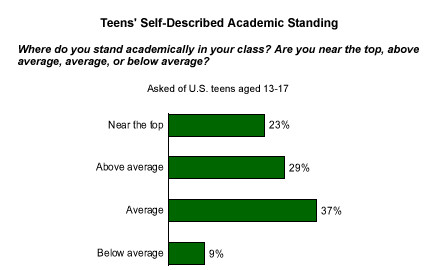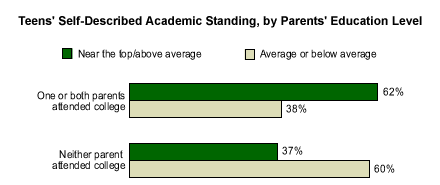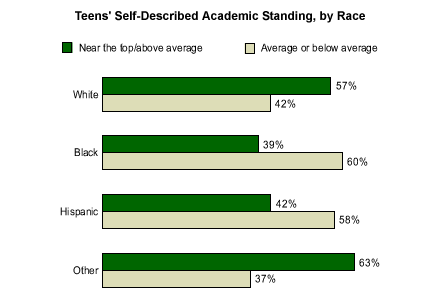For years, Gallup has asked teens where they think they stand academically in comparison with their classmates. Aggregated data from the last two Gallup Youth Surveys* allow a closer look at how teens rank their academic performance, and whether some groups see themselves in a better light than others do.
Overall, teen assessments of their class standing divide about equally -- 52% of teens say they are "near the top" (23%) or "above average," (29%) in their class, while 46% define their performance as "average" (37%) or "below average" (9%).

An infinite number of issues may come into play when teens consider their class standing -- from external measures such as grades, to placement in vocational or college prep courses, to more complex, internal yardsticks such as feelings of self-worth and perceived teacher or parental expectations. And because academic standing is a relative assessment, the academic prowess of one's peers is a key factor. Chase, a 17-year-old senior at Princeton (N.J.) High School, says he would have to describe his class standing as average, but offers an immediate qualifier. "At any other high school, I would be above average. All the kids in this school are really, really smart."
Race and Parents' Level of Education
As might be expected, several indicators of socioeconomic status appear related to teens' academic self-assessments. Large variations are found between teens with one or two college-educated parents and teens whose parents have not attended college. Sixty-two percent of teens with two college-educated parents feel they are above average academically, compared with 37% of teenagers whose parents do not have college educations. Teens with two college parents are more than twice as likely to say they are "near the top" of their class than those who did not have either parent attend college (37% vs. 15%).

Wide discrepancies appear between white teens and minority teens (especially black teens and Hispanic teens) when they are asked to evaluate their class ranking. A majority of non-Hispanic white teens (57%) see themselves on the upper rungs of the academic ladder, whereas majorities of black teens (60%) and Hispanic teens (58%) define their standing as average or below average.
In her 2002 book, African-American Teens Discuss Their Schooling Experiences, Gail L. Thompson discusses two widely held grievances that contribute to the achievement gap in minority education. "One of the most obvious ways in which the educational system has been detrimental to African-American children is through tracking, the practice of sorting children into different academic groups or ‘tracks.'A disproportionate number of African American and Hispanic children are placed in lower-level academic tracks instead of college preparatory tracks. Conversely, African-American children are overrepresented in Special Education classes," she writes.

Bottom Line
Not only can low academic self-esteem aggravate depression and possible risk behaviors, but from a pragmatic standpoint, it can discourage teens from getting their high school diploma -- thus abandoning the major entry point to an economically better life. A Census Bureau report finds that an average full-time worker with a high school diploma will earn $30,400 annually, while someone who did not graduate from high school will earn only $23,400 on average.
There is some encouraging news on this front. According to the National Center for Education Statistics, high school dropout rates have fallen over the past 30 years. The dropout rate for white 16- to 24-year-olds fell from 12% in 1972 to 7% in 2001(the last year for which statistics are available). The dropout rate has declined by almost half for blacks -- from 21% in 1972 to 11% in 2001, but unfortunately has remained relatively constant for Hispanics. About 3 in 10 Hispanic students quit school every year.
"Attack the soft bigotry of lower expectations," a No Child Left Behind fact sheet proposes as the solution to bridging the achievement gap between Hispanic, white, and black students, "and demand that schools close the achievement gap." Parents and educators must continue to work tirelessly to heed that call.
*The Gallup Youth Survey is conducted via an Internet methodology provided by Knowledge Networks, using an online research panel that is designed to be representative of the entire U.S. population. The questionnaires were completed by 1,985 respondents aged 13 to 17 between Jan. 23-Feb. 10, 2003, and Jan. 22-March 9, 2004. For results based on the total sample, one can say with 95% confidence that the maximum margin of sampling error is ±2 percentage points.